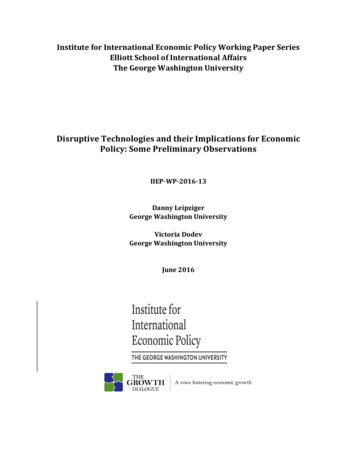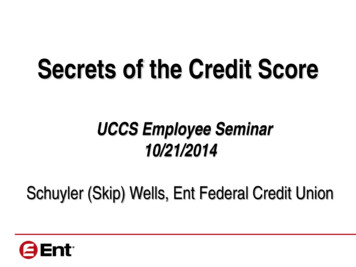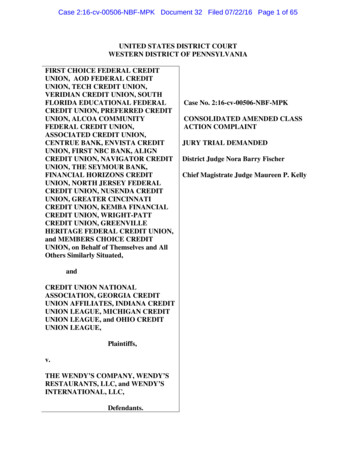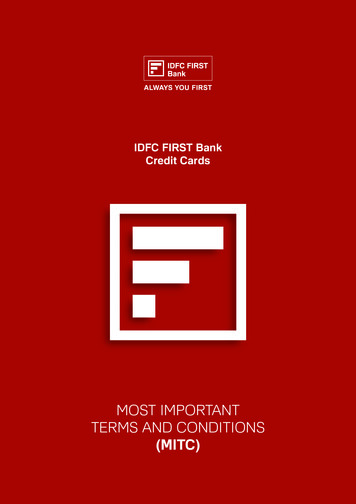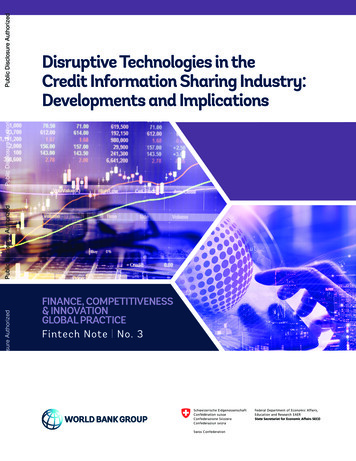
Transcription
Public Disclosure AuthorizedPublic Disclosure AuthorizedPublic Disclosure AuthorizedPublic Disclosure AuthorizedDisruptive Technologies in theCredit Information Sharing Industry:Developments and ImplicationsFINANCE, COMPETITIVENESS& INNOVATIONGLOBAL PRACTICEFintech Note No. 3
2019 The World Bank Group1818 H Street NWWashington, DC 20433Telephone: 202-473-1000Internet: www.worldbank.orgAll rights reserved.This work is a product of the staff of The World Bank Group. The World Bank Group refers to themember institutions of the World Bank Group: The World Bank (International Bank for Reconstructionand Development); International Finance Corporation (IFC); and Multilateral Investment GuaranteeAgency (MIGA), which are separate and distinct legal entities each organized under its respectiveArticles of Agreement. We encourage use for educational and non-commercial purposes.The findings, interpretations, and conclusions expressed in this volume do not necessarily reflect theviews of the Directors or Executive Directors of the respective institutions of the World Bank Group orthe governments they represent.The World Bank does not guarantee the accuracy of the data included in this work. The boundaries,colors, denominations, and other information shown on any map in this work do not imply any judgmenton the part of The World Bank concerning the legal status of any territory or the endorsement oracceptance of such boundaries.Rights and PermissionsThe material in this work is subject to copyright. Copying and/or transmitting portions or all of this workwithout permission may be a violation of applicable law. The World Bank encourages dissemination ofits work and will normally grant permission to reproduce portions of the work promptly. Because theWorld Bank encourages dissemination of its knowledge, this work may be reproduced, in whole or inpart, for noncommercial purposes as long as full attribution to this work is given.Any queries on rights and licenses, including subsidiary rights, should be addressed to the Office ofthe Publisher, The World Bank, 1818 H Street NW, Washington, DC 20433, USA; fax: 202-522-2422;e-mail: pubrights@worldbank.org.Photo Credits: Shutterstock.com
Table of ContentsAcknowledgmentsIIIAbbreviations and AcronymsVExecutive SummaryVII1. Overview of Credit Information SystemsIntroductionCredit Reporting EcosystemBenefits of Credit Information SharingCredit Information Solutions Offered by the World Bank Group112342. Trends and Innovations in Disruptive TechnologiesIntroductionProliferation of Big DataEmergence of New TechnologiesRisks, Challenges, and Opportunities77810123. Implications of Disruptive Technologies on Credit ReportingEvolving Credit Reporting Landscape: FirmsEvolving Credit Reporting Landscape: Models, Data Types, Sources,Ownership, and PrivacyEvolving Credit Reporting Landscape: Development171719264. Regulatory and Supervisory Approaches to FintechStandards for Fintech and Alt Data29305. The Role of the World Bank Group356. Conclusions37Annex. General Principles for Credit Reporting39Endnotes41TABLE OF CONTENTSI
List of BoxesBox 1: What Is Big Data?Box 2: Potential for Discriminatory LendingBox 3: Risks and Challenges Associated with Big Data and FintechBox 4: Opportunities Associated with Adoption of Big Data and FintechBox 5: Alternative Lenders: Kabbage, Amazon, M-Shwari, CapitalFloat, and Pay-As-You-GoSolar MarketsBox 6: Alternative Scoring CompaniesBox 7: Psychometric Tests—Entrepreneurial Finance Lab and CreditinfoBox 8: Use of Open Data Platforms—BonifyBox 9 Distributed Ledger Technologies and Biometrics in Credit ReportingBox 10: Biometrics —Uganda and IndiaBox 11: Fintech Laws and Regulatory Framework in the European Union, Switzerland, China,and MexicoBox 12: Automated Data Collection in Austria and RwandaList of FiguresFigure 1: Key Participants in a Credit Reporting SystemFigure 2: Illustration of Structured and Unstructured DataFigure 3: Four V’s of Big DataFigure 4: New Technologies Used in the Credit Reporting IndustryFigure 5: Risks, Challenges, and Opportunities of Using New Technology in Credit ReportingFigure 6: Types of Data Used for Credit ReportingFigure 7: Countries with Regulatory SandboxesFigure 8: Guidelines for Policy Makers and Regulators to Address FinTech from the BaliFintech AgendaList of TablesTable 1: Benefits of Credit Information Flow to Different StakeholdersTable 2: IDC Financial Insights Fintech Ranking ListTable 3: Potential Development Impact of New Data Technologies, Products, and ModelsTable 4: World Bank Group’s Role in New Data 4252736DISRUPTIVE TECHNOLOGIES IN THE CREDIT INFORMATION SHARING INDUSTRY: DEVELOPMENTS AND IMPLICATIONS
AcknowledgmentsThis note is a product of the Financial Inclusion, Infrastructure and Access Unit inthe World Bank Group’s Finance, Competitiveness and Innovation Global Practice.This discussion note was prepared by Luz Maria Salamina (lead financial sectorspecialist), Pratibha Chhabra (operations officer), Shalini Sankaranarayan (seniorfinancial sector specialist), and Collen Masunda (financial sector consultant), and thework was carried out with the support of the credit reporting team of lead specialists:Oscar Madeddu, Colin Raymond, Fabrizio Fraboni, and Hung Hoang Ngovandan.The note also benefited from the peer reviewers Matthew Saal (lead financialsector specialist, World Bank Group), Emma Thomas (head of government andpublic affairs, UK&I, and EMEA Experian), Paul Randall (executive directorfor global solutions, Creditinfo Group), and Valeria Racemoli (regulatory andinnovation support, CRIF Information Solutions), who provided their valuablecomments and inputs.Mahesh Uttamchandani (practice manager) provided overall guidance to the team.The team gratefully acknowledges the generous financial support of the Swiss StateSecretariat for Economic Affairs (SECO).A special thanks goes to Aichin Lim Jones (Graphic Designer) for her work on thedesign, layout, and graphics of this publication.ACKNOWLEDGMENTSIII
IVDISRUPTIVE TECHNOLOGIES IN THE CREDIT INFORMATION SHARING INDUSTRY: DEVELOPMENTS AND IMPLICATIONS
Abbreviationsand AcronymsAIArtificial IntelligenceBanxicoBank of MexicoBISBank for International SettlementsCBRCChina Banking Regulatory CommissionCGAPConsultative Group to Assist the PoorCIITOChina Internet Information Technology OfficeCIRCChina Insurance Regulatory CommissionCISCredit Information SystemsCNBVNational Banking and Securities CommissionCRSCredit Reporting SystemCRSPCredit Reporting Service ProviderDLTDistributed Ledger TechnologyEFLEntrepreneurial Finance LabEMEAEurope, Middle East and AfricaEUEuropean UnionFINMASwiss Financial Market Supervisory AuthorityFSBFinancial Stability BoardGPGeneral Principle (for Credit Reporting)GPFIGlobal Partnership for Financial InclusionGPSGlobal Positioning SystemGCRPGlobal Credit Reporting ProgramICCRInternational Committee on Credit ReportingABBREVIATIONS AND ACRONYMSV
VIIDCInternational Data CorporationIFCInternational Finance CorporationIMFInternational Monetary FundMIGAMultilateral Investment Guarantee AgencyMLMachine LearningMSMEMicro, Small and Medium EnterpriseODPOpen Data PlatformPBOCPeople’s Bank of ChinaQRQuick ResponseSECOSwiss State Secretariat for Economic AffairsSHCPSecretaría de Hacienda y Crédito PúblicoSMESmall Medium EnterpriseSMSShort Message ServiceWBGWorld Bank GroupDISRUPTIVE TECHNOLOGIES IN THE CREDIT INFORMATION SHARING INDUSTRY: DEVELOPMENTS AND IMPLICATIONS
Executive SummaryFinancial inclusion is now widely recognized, in the international developmentcommunity and by policy makers in developed and developing economies, asimportant to development. An estimated 2 billion adults globally do not have accessto a transaction account that can be used to receive payments and make deposits.1Research shows that low-income and financially excluded populations have activefinancial lives and need a range of financial services to take advantage of economicopportunities and manage and mitigate risks. Small and medium enterprises (SMEs)generate the greatest number of new jobs and employ the largest number of peoplein aggregate; thus they are important for job creation and economic growth. And yet,according to the World Bank Group’s SME Finance Forum,2 65 million or 40 percentof formal micro, small, and medium enterprises (MSMEs) in developing countrieshave unmet financing needs. The MSME finance gap in developing countries isestimated to be 5.2 trillion or approximately 1.4 times the current level of MSMElending, and women-owned businesses comprise 28 percent of MSMEs and accountfor 32 percent of the MSME finance gap.Improving access to financial services plays an important role in reducing the world’spoverty levels and increasing shared prosperity. Financial inclusion is aligned withthe World Bank Group (WBG) commitment to reduce poverty, increase sharedprosperity, and promote sustainable development. Recognizing the transformationalpotential of financial inclusion for economic development, WBG and partners putforward an ambitious goal of universal financial access by 2020.3Credit information systems (CIS) help ensure financial stability by enablingresponsible access to finance. They also can play an instrumental role in expandingaccess to credit and other services on credit to the underserved and unbanked. CISfacilitate lending processes by providing objective information that enables lendersto reduce their portfolio risk, reduce transaction costs, and expand their lendingportfolios. By doing so, credit reporting systems enable lenders to expand accessto credit to creditworthy borrowers, including individuals with thin credit history,microentrepreneurs, and SMEs.4The world is becoming increasingly digitized, and that development has led to anexplosion in the different types of data, technologies, and products available. Fromartificial intelligence to cryptography, rapid advances in digital technology aretransforming the financial services landscape, creating opportunities and challengesEXECUTIVE SUMMARYVII
for consumers, service providers, and regulators alike.The Bali Fintech Agenda developed by the InternationalMonetary Fund (IMF) and World Bank defines fintechas “the advances in technology that have the potentialto transform the provision of financial services spurringthe development of new business models, applications,processes, and products.5These fintech developments also have implications forthe credit reporting industry. The industry itself, theproduct of years of evolution in response to market needs,has already been gradually adapting and leveragingthese new developments to better serve market needsand enable greater financial inclusion. The use ofalternative data and the digitalization of consumer andSME finance represent a large opportunity to expandaccess to finance to unserved and underserved marketsegments.6 A rapidly growing crop of technologyfocused consumer and SME lenders and analyticsproviders (“fintechs”) are putting the use of consumerand SME digital data, customer needs, and advancedanalytics at the center of their business models, settingforth new blueprints for disrupting conventionalconsumer and SME lending. The credit reportingindustry has always provided cutting-edge technology,and innovation remains at the core of its business.Most of the traditional providers of credit reportingsystems are in fact listed as top-ranking fintechs. Yetthe spread of new credit providers and the proliferationVIIIof potentially credit-relevant data from nontraditionalsources put pressure on this ability to innovate as wellas on the core business model of aggregating credit datafrom financial service providers.Principle 4 of the G20 High-Level Principles onDigital Financial Inclusion recognizes the role thatfinancial information infrastructure and servicesplay in expanding the safe, reliable, and low-costprovision of digital financial services, particularlyfor underserved rural areas. Specifically, it advocatesfor the establishment and responsible use of flexible,dynamic credit reporting systems modeled on bestpractices as outlined by the International Committeeon Credit Reporting (ICCR). It also encouragesthe use of innovative data sources in CISs, such asdata on utility payments, mobile airtime purchases,data on digital wallet or e-money accounts, ande-commerce transactions, keeping in mind consumerdata protection and privacy rules as well as consumeridentification systems.7Within this context, this note analyzes the evolutionof CISs, including the emergence of new technologiesthat use alternative data in credit decisioning and theopportunities and risks associated with these trends.This paper also predicts the potential developmenteffect of these disruptive technologies and proposesa role for the World Bank Group in leveraging thesetechnologies to promote inclusion and stability.DISRUPTIVE TECHNOLOGIES IN THE CREDIT INFORMATION SHARING INDUSTRY: DEVELOPMENTS AND IMPLICATIONS
1.Overview of CreditInformation SystemsIntroductionWell-functioning financial markets contribute to sustainable growth and economicdevelopment, because they typically provide an efficient mechanism for evaluatingrisk and return to investment, and then managing and allocating risk. Financialinfrastructure is a core part of all financial systems. The quality of financialinfrastructure determines the efficiency of intermediation—the ability of lendersto evaluate risk and of consumers to obtain credit, insurance, and other financialproducts at competitive terms. Credit reporting is a vital part of a country’sfinancial infrastructure and is an activity of public interest.8 Comprehensive creditreporting systems contribute to increased financial inclusion, responsible finance,and financial stability.Credit reporting addresses a fundamental problem of credit markets: asymmetricinformation between borrowers and lenders, which may lead to adverse selection, creditrationing, and moral hazard problems. Regulators and financial market participantstherefore increasingly recognize the value of credit reporting systems (CRSs) to improvecredit risk evaluation and overall credit portfolio management, to enhance financialsupervision and financial sector stability, and as a tool to enhance access to credit.According to the World Bank’s Doing Business 2018,9 approximately 134 countriesof 183 countries surveyed had either a credit bureau or a credit registry at the endof 2016. The credit reporting industry has experienced unprecedented growth since2000, especially in emerging markets. This growth was driven by several factors: High growth of retail credit in emerging markets. Between 1985 and 1995,unfavorable macroeconomic environments and structural restrictions in creditmarkets in emerging economies constrained credit growth. With the rapidincrease in the provision of credit as well as entrance of new types of lendersin the retail credit market, the need for credit information and for streamlininglending processes grew, leading to the establishment of CRSs and greaterdemand for these types of reforms. Broad reforms stemming from the financial crisis. The 2008 financial crisisprovided major impetus for broad reform efforts at the national level as authoritiesin developed and emerging markets realized the need for strengthening andimproving financial infrastructure, including CRSs. The introduction and rolloutof the Basel III accords, which raised the capital provisioning requirements for1. OVERVIEW OF CREDIT INFORMATION SYSTEMS1
banks, also underlined the need for more stringentrisk assessment and management frameworks.That need, in turn, has motivated an interest indeveloping or reforming credit registries to collectcredit data that can support both micro and macroprudential supervision and regulation.level of security in using a single solution to servemultiple markets. Markets with small populationsor small credit markets and markets with a greatdeal of regional integration and movement ofjobs, people, and credit across borders stand tobenefit from hub-and-spoke solutions. Innovation in the credit reporting space. Sincethey first emerged, credit bureaus have alwaysleveraged new technologies and innovations toimprove efficiency, lower the cost of financing,increase the speed of service, and improve thequality of the information provided to the usersof these services. In other words, the creditinformation sharing space is no stranger todisruption. The earliest disruption in credit marketscan be traced to the 1950s, with the introduction ofcredit scoring and the automation of workflow andcredit underwriting processes by CRS providers.During the 1970s, the industry harnessed thepower of mainframe computers and databases toprocess, organize, and report on credit data andrealized tremendous operating efficiencies thatenabled them to process data faster and attractmore business. Credit bureau as a portal. Another example ofinnovation that credit bureaus introduced wasa portal or “one-stop shop,” which facilitatesonline links to other relevant data sources, suchas company registers, vehicle registry, voterrolls, land title registers, and so on. The bureausevolved beyond being an aggregator of lenders’credit information to include information neededto verify applicants, check ownership of assets,check encumbrances, provide property valuations,and so on. Automated lending solutions. Given the volumeof decisions often required to manage a typicalcredit retail portfolio (such as grant or rejectfacility, over-limit authorization, cross-sell orup-sell strategies, and past due action required),lenders in developed credit markets have turnedto automation to maintain efficiency. However,raw data in the form of a credit report can beextremely difficult to integrate into such systems.For more than 30 years, credit bureaus havebeen providing automated lending solutions thateliminate the need for tedious manual sorting ofpaper and electronic files and that reduce the costsassociated with such processing. Hub-and-spoke solutions. Another keyinnovation in the credit reporting space was thedevelopment of hub-and-spoke solutions. Withthe improvements in database managementsoftware and the decreasing costs of storingand processing data—as well as the decreasingcosts of hardware—credit information serviceproviders introduced hub and spoke models, whichleveraged economies of scale and increased the2Credit Reporting Ecosystem At their core, CRSs consist of databases ofinformation on debtors, together with theinstitutional, technological, and legal frameworkthat supports the efficient functioning of suchdatabases. The information stored in these systemscan relate to individuals, legal entities, or both.The “Credit Reporting Systems” are broadlyclassified as credit bureaus, credit registries, andcommercial credit reporting companies based onthe core functions they serve.10 Credit bureaus collect information from creditorsand available public sources on a borrower’scredit history. The bureau compiles informationon individuals and small firms, such as data incredit repayment records, court judgments, andbankruptcies, and then creates a comprehensivecredit report that is sold to creditors. Some ofthe more prominent consumer credit bureaus thathave a global presence include Experian, Equifax,TransUnion, CreditInfo, CRIF, and Compuscan. Credit registries collect and compile informationfrom regulated financial institutions and aregenerally used to support the financial systemsupervision function of most central banks.Generally, information is collected on large creditexposures that represent systemic risk exposuresin a given market. Credit registries also provideDISRUPTIVE TECHNOLOGIES IN THE CREDIT INFORMATION SHARING INDUSTRY: DEVELOPMENTS AND IMPLICATIONS
credit reports that show aggregate loan exposuresto the regulated financial institutions that submitdata to the credit registry. Commercial credit reporting companies are entitiesthat collect information solely on businesses,including sole proprietorships, partnerships, andcorporations, for credit risk assessment, for creditscoring, or for other business purposes such as theextension of trade credit. These entities collectcredit data from banks, other regulated financialinstitutions, nonfinancial lenders, and other sources,and they generally target the lending marketsegments serving medium and large companies.11Credit bureaus also collect information on smalland medium-size businesses; however, unlikecommercial credit reporting companies that focussolely on businesses, the primary focus of creditbureaus is on the information of individuals.Whereas different models and structures of creditreporting exist throughout the world, each of theminvolves a large number of actors that intervene atone or more points throughout the cycle of producing,collecting, storing, processing, distributing, and, finally,using information to support credit-granting decisionsand financial supervision. Figure 1 identifies the keyparticipants involved in each step.12Benefits of Credit Information SharingWhen comprehensive credit information is sharedand when safe, efficient, and reliable infrastructuresare available, the cost of financial intermediationfalls and financial products and services becomeaccessible to greater numbers of borrowers; further,lenders and investors have greater confidence in theirability to evaluate and price risk. Credit bureaus andcommercial credit reporting companies help addressthe fundamental issue of “information asymmetry,”whereby the borrower knows the odds of repayinghis or her debts much better than the lender does.The inability of the lender to accurately assess thecreditworthiness of the borrower contributes tolower acceptance rates for loan applications andto higher interest and default rates, and it affectsthe profitability of the financial institution. Creditregistries provide a useful tool by which financialsystem supervisors and regulators can monitorsystemic risk levels and take appropriate measuresto maintain financial stability. See table 1 for a viewof these benefits.Figure 1: Key Participants in a Credit Reporting System Individuals Businesses CreditorsGovernment AgenciesData SubjectsNonfinancial CreditorsDataSubjectsData Providers/Other DataSourcesUsersServiceProviders CreditorsNonfinancial creditorsOther Private DatabasesPublic Records Agencies Credit Bureaus Credit Registries Commercial CreditReporting CompaniesSource: World Bank, “The General Principles for Credit Reporting,” 2011.1. OVERVIEW OF CREDIT INFORMATION SYSTEMS3
Table 1: Benefits of Credit Information Flow to Different lternative dataproviders Stakeholders are able to see the client’s complete range of credit obligations, paymentsstatus, and level of indebtedness or overindebtedness. Stakeholders are able to price risk appropriately and provide custom products andservices to meet the specific needs of clients. Stakeholders can assess new borrowers with no formal credit histories (specifically lowincome groups, women borrowers, small and medium-size enterprises). Stakeholders have tools to proactively manage consumer accounts, such as credit lineincreases and decreases, payment terms, interest rates, and so on. Stakeholders can proactively manage collections so as to make the collections processmore streamlined and to expend effort where needed to maximize collections whererecovery rate is highest.Consumers Credit reporting enables consumers to establish “reputational collateral,” based on credithistories, thus reducing the need for physical collateral. Consumers with on-time payments, no missed payments, and other good borrowing andrepayment behavior will stand to benefit and creditors may offer them better terms ofcredit or higher credit lines. Consumers can benefit from reporting of nontraditional data, such as payments fortelephone bills, utilities, and other charges, to the credit bureau. Those consumers thatdo not have formal relationships with banks and other creditors can show that they meetother payment obligations responsibly and are worthy of credit.Regulators andsupervisors Comprehensive information sharing enables regulators and supervisors to developappropriate regulatory tools to assist in macro and micro prudential supervision. It provides supervisors with the necessary information to support systemic risk monitoringand prudential supervision.Credit Information Solutions Offeredby the World Bank GroupThe World Bank Group emphasizes building thecapacity of service providers, authorities, and usersto develop and improve credit reporting systemsand, ultimately, make them more efficient, safe, andreliable. This holistic approach includes working withgovernments and all other stakeholders to (a) devisea national strategy for credit information systems(CISs), (b) develop infrastructure, (c) establish legaland regulatory frameworks and determine the roleof authorities in the CISs, and (d) improve consumerawareness and protection frameworks. Additional areasof focus include improved availability of digital datafrom relevant sources to support financial inclusion,financial sector supervision, and regulation andcompetition in the credit market, along with efforts toensure the safety and efficiency of the CISs.The following are areas in which the World Bank’sCredit Reporting Systems team provides technicalassistance to diverse client segments:4 Diagnostic Assessments Make assessments against the General Principlesfor Credit Reporting. Make assessments against the G20 Frameworks. Legal and Regulatory Framework Review, develop, and support the amendment ofthe legal framework that involves CRSs. Support implementation of the law. Institutional Framework Develop and enhance credit reportinginfrastructure (bureaus, registries). Develop products (such as scoring and othertools). Enhance data (data sources, collection tools, andso on). Consumer Protection Design strategy. Design and support awareness campaigns. Develop methodologies for handling consumercomplaints.DISRUPTIVE TECHNOLOGIES IN THE CREDIT INFORMATION SHARING INDUSTRY: DEVELOPMENTS AND IMPLICATIONS
Develop methodologies for collaborationbetween authorities. Design financial literacy programs.Since the Global Credit Reporting Program (GCRP)was launched in 2001, it has supported the developmentof credit bureaus and registries in about 60 countriesglobally, and it is currently active in 40 countries.Through technical assistance and advisory services, theGCRP team has supported the development of CRSsin emerging markets where little to no informationsharing had existed. The adoption of best practicesand the guidance provided have led to creation ofa sophisticated credit risk management culture inthese markets. Progress has included demand forstrengthening methods for systemic risk monitoring andrisk prevention and widespread acceptance of the needfor strong enabling legal and regulatory frameworks tosupport the development of these CRSs.In each of its project countries, the GCRP has supportedthe reform of the legal and regulatory framework forcredit reporting, facilitated the establishment or reformof credit bureaus and registries, conducted extensiveoutreach and awareness-raising workshops, and builtthe capacity of key stakeholders. For instance, theGCRP supported the development of a regional creditbureau in Central America, helped set up the first creditbureaus in Cambodia, the Arab Republic of Egypt,Guyana, Jamaica, Lao People’s Democratic Republic,Morocco, and Tajikistan; and worked on the legal andregulatory framework in the Organisation of EasternCaribbean States, Kenya, and Panama. It continues toassist the development of CRSs in Azerbaijan, India,Liberia, Mongolia, Tanzania, Vietnam, and elsewhere.Since 2002, the World Bank has also been monitoringcredit reporting environments in more than 180countries through the World Bank’s flagship DoingBusiness publications.The combined coverage of individual borrowers bycredit bureaus in these countries as of 2017 is morethan 867 million,14 implying that many people nowhave a credit history and are able to access credit on thebasis of their credit history.In 2011, the World Bank Group, as a part of aninternational task force and with the support of the Bankfor International Settlements (BIS), led the developmentof the General Principles for Credit Reporting (GPCR),which represent the only universal set of standardsfor credit reporting. The GPCR are the only existingset of standards included under the Financial StabilityBoard (FSB) noncore compendium of standards for thefinancial sector and is extensively used by regulators,supervisors, and policy makers alike in guiding thereform of credit reporting systems. The GPCR has fiveprinciples (see annex A) and describes the respectiveroles of key stakeholders, accompanying guidelines,and recommendations for effective oversight.In addition to the individual reform projects invarious countries, the World Bank acts as chair to theInternational Committee on Credit Reporting (ICCR)and hosts its secretariat. The ICCR was formed from theinitial task force that developed the GPCR. The ICCRhas also produced several reports that provide guidanceto the development of CRSs around the world. Theseinclude “Assessment Methodology for the GeneralPrinciples for Credit Reporting,” “Facilitating SMEFinancing through Improved Credit Reporting,” “TheRole of Credit Reporting in Supporting Financial SectorRegulation and Supervision,” and “Use of AlternativeData to Enhance Credit Reporting to Enable Access toDigital Financial Services by Individuals and SMEsoperating in the Informal Economy.”151. OVERVIEW OF CREDIT INFORMATION SYSTEMS5
6DISRUPTIVE TE
II DISRUPTIVE TECHNOLOGIES IN THE CREDIT INFORMATION SHARING INDUSTRY: DEVELOPMENTS AND IMPLICATIONS List of Boxes Box 1: What Is Big Data? 9 Box 2: Potential for Discriminatory Lending 13 Box 3: Risks and Challenges Associated with Big Data and Fintech 14



